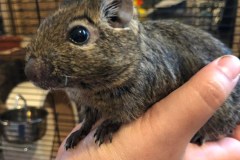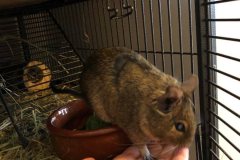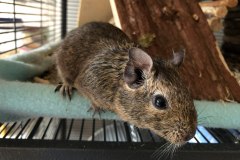Localized fur loss, especially on the legs, is common in Octodon degus. Alopecia are bare areas and can have different origins. It is also possible that the degu, by excessive licking, creates a loss of fur which can sometimes be very impressive.
Please note that this article was translated with the help of DeepL. If you notice any mistakes, please send us an email at octodons.lesite@gmail.com! Thank you for your help!
Only a qualified veterinarian with knowledge of the Octodon degus is able to diagnose and treat the disease. Be careful not to self-diagnose your animals, as this can lead to a worsening of the condition.
Stereotypy or disease ?
Alopecia is the acceleration of hair loss. It can be of behavioural origin01, linked to a treatment (such as chemotherapy) or to a skin pathology. The most common alopecia in degus is stress-related and triggers fur loss on the paws02. Fur loss occurs in up to 1/3 of captive degus03, , it is one of the most common pathologies after dental malocclusions. However, the degu can be affected by other diseases with similar symptoms. In the case of excessive licking, a veterinarian should first be consulted to rule out other health problems. Behavioural diagnosis should not rule out an underlying condition.

Causes
Alopecia can have many causes, such as :
- Fur loss, or systemic diseases, hormonal disorders: very rare in degus, however, other pathologies are not to be excluded in the diagnosis.
- Nutritional deficiency: the degu requires a special diet, mainly composed of fibres and with a level of Calcium adapted to the species. A bad diet can create skin problems02 and cause fur loss.
- An intensive moult: it happens that during intensive moults, the loss of fur is such as the degu is “stripped” by places.
- Certain drugs: in particular chemotherapy (not prescribed in the degu).
- A mycotic infection: micro fungi can be at the origin of the loss of fur. These include mainly ringworm, which is a zoonosis (transmissible to humans).
- External parasites: some parasites can cause fur loss in degus04.
- A lesion: it is possible that the degu, by a traumatic lesion, has a localized loss of fur04. These lesions can be linked to a burn, an injury, a repeated rubbing, …
- Poor hygiene: hygiene of the cage is an important factor, which can lead to a proliferation of bacteria causing fur loss.
- Pain: pain can also be one of the causes of alopecia by self-mutilation or excessive licking.
- Stress: whether physical (surgery, illness) or psychological (too much noise, predators nearby, etc.).
- Stereotypy: induced by stress, licking stereotypy (be careful, this is not excessive grooming) or self-mutilation can induce alopecia, whether it is performed on other dogs or by the degu on itself. Alopecia stereotypies are to be distinguished from grooming behaviour. They are expressed by licking, plucking fur, scratching, or sucking and are present when the animal shows a form of permanent anxiety. The degu then loses its self-control and does not stop during these activities.
- Dental problem: the pain of a dental problem can induce fur pulling behaviour and thus lead to localised fur loss. It is important to note that dental problems affect up to 76% of degus and are related to poor nutrition03.
Symptoms
Alopecia due to stereotypy or stress leads to fur loss mainly localised in the degu on the front or back legs. When this behaviour is reproduced on a congeneric, it is often localised on the back, around the head, etc…
The skin may be raw, with visible lesions, bite marks or red patches.
Types of alopecia in the degu
There are several types of alopecia in the degu, which lead to a loss of fur that can be important. For the degus, the different types are still poorly documented, but the behavioural cause seems to be the most important to date03.
Behavioural alopecia
Excessive licking due to stress or pain is one of the most common causes02. It is mainly related to poor housing conditions of the degu (social isolation, lack of enrichment) or to a dysfunctional social group. In the case of self-mutilation, it is the paws of the degu that are most affected. When it is a case of “over-grooming” by a fellow octodon, the flanks and lower back are the most targeted areas.

Treatments
In order to avoid alopecia in degus, it is important to provide them with decent housing conditions. Indeed, it is important to respect the natural social structure of the octodon, or to get as close as possible to it (4-6 females for 1-2 males05. But it is also essential to provide them with occupations, for example via tunnels, hiding places or wheels. Enrichments are essential 06, especially for foraging, in order to reproduce a natural behaviour and to allow the degu to occupy itself during its days. Finally, the degu should be protected from excessive exposure to light and sound, as well as potential predators (dogs, cats, …) that could cause stress07.
Photographies of comportemental alopecia by: Degoe-opvang Jodipro

Alopecia due to mycotic infection (dermatophytosis)
In a few cases, dermatophytosis has been the cause of fur loss in Octodon degus03. This is a mycotic disease, which is a potential zoonosis. The most common in rodents of the degu family is Trichophyton mentagrophytes, and is not visible under Wood’s light.
Treatments
Treatment with an antifungal agent is necessary, after determining via fungal culture if dermatophytosis is clinically suspected.
Other described alopecia
A few other cases of fur loss have been described in Octodon degus03. These include bacterial dermatitis, which is related to poor hygiene conditions. Ectoparasitic dermatitis has also been observed, although very rare and caused by the mites Demodex and Ornithonyssus bacoti. The latter parasite is transmissible to humans and causes skin lesions. Finally, two cases of tumours have been observed (myxosarcoma and histiocytoma) and linked to localised fur loss.
Sources
- Dermatologie et troubles comportementaux : une démarche globale[↩]
- Handbook of exotic pet medicine[↩][↩][↩][↩]
- Diseases in pet degus: A retrospective study in 300 animals[↩][↩][↩][↩][↩][↩]
- Diseases of small domestic rodents[↩][↩]
- Instability Rules Social Groups in the Communal Breeder Rodent Octodon degus)[↩]
- LES PSYCHODERMATOSES CHEZ LE CHIEN[↩]
- BVASA manual of rodents and ferrets[↩]








My dago has a spot about the size of a dime on his left hip doesn’t seem to get any bigger any information would be helpful
Hello,
I invite you to check if he can exert himself physically enough, or if one of his partners pulls out his fur. You can add wheels and hide food to keep him busy.